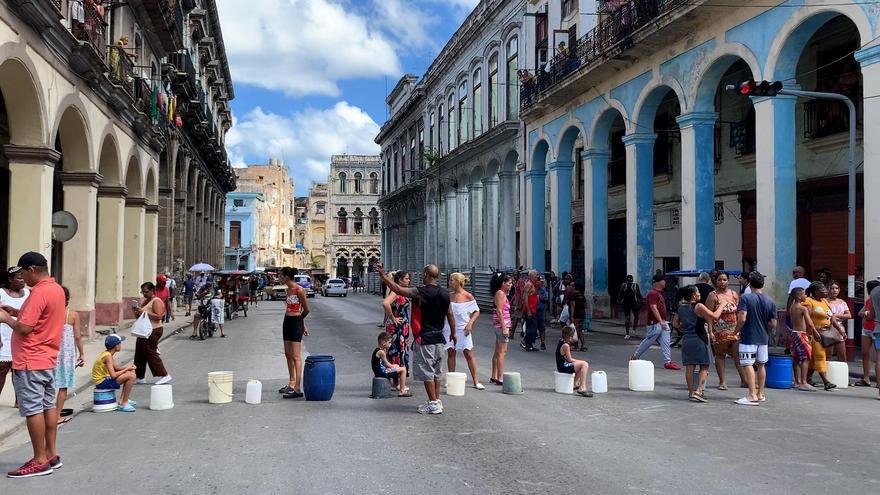
![]() 14ymedio/EFE, Havana,12 November 2023 — With buckets, tanks and other containers, a dozen women with their children blocked the way for vehicles on Monte Street on the corner of Agramonte Street in Old Havana. After several days without any water supply, residents in the area decided to cut off traffic this Saturday in protest of the situation they are suffering.
14ymedio/EFE, Havana,12 November 2023 — With buckets, tanks and other containers, a dozen women with their children blocked the way for vehicles on Monte Street on the corner of Agramonte Street in Old Havana. After several days without any water supply, residents in the area decided to cut off traffic this Saturday in protest of the situation they are suffering.
“We are not doing anything illegal, we are demanding our right,” said one of the neighbors through a video broadcast by the CubaNet news portal. “When the water truck comes we’ll leave,” said another.
The women sat along the street and remained in place for about half an hour until the police arrived. The agents took the names of several of the protesters and asked some people who were recording the scene for identification.
According to CubaNet, a short time later three tanker trucks with water arrived in the neighborhood.
The agents took the names of several of the protesters and asked some people who were recording the scene for identification
This type of protest is increasingly common in Cuba where the lack of a water supply affects 450,000 people throughout the country, of which more than 156,000 lack adequate access due to the poor state of hydraulic infrastructure and other problems.
Last September, the residents of Dragones Street, between Rayo and San Nicolás, in Central Havana, built an improvised barricade that forced the authorities to transport a tanker truck to the neighborhood suffering from lack of water. The improvised wall, made of buckets, plastic tanks and other household items, prevented the passage of vehicles and police patrols for hours.
The constant breakdowns of pumping equipment, the poor state of the pipe network and the drought have combined to aggravate the water supply situation in the Cuban capital.
The Havana Water Company has recognized the poor situation of supply services throughout the capital, more serious in areas such as Cerro, Plaza de la Revolución, Diez de Octubre, Centro Habana and Habana Vieja.
In the last twelve months, 88% of the average historical rainfall has been recorded, which has caused a reduction in stored water and groundwater.
A report from the Institute of Meteorology (Insmet) indicated that the drought affected 27% of Cuba during May, June and July due to the deficit in accumulated rainfall of more than 60%.
The report from the specialized organization, corresponding to the end of the summer, specifies that the most affected provinces were Pinar del Río, Artemisa, Havana, Mayabeque and Matanzas (all in the west of the country).
Insmet added that continued low rainfall, known as “meteorological drought,” predominated in that region.
About 59% of the country’s 168 municipalities presented a “moderate to extreme” drought in the period, according to the report presented on the Insmet website.
In the last 12 months, 88% of the average historical value of rainfall has been recorded, which has caused a reduction in stored and groundwater. Cuban experts predict more “recurrent and intense” droughts due to the effects of climate change.
“Around 2,070,000 people receive [water] service every 3 days or more, and there are 478 population settlements with more than 2,000 inhabitants that do not have – totally or partially – aqueduct networks,” indicated the president of the National Institute of Hydraulic Resources ( INRH), Antonio Rodríguez cited in the official newspaper Granma.
The INRH director mentioned that last June alone, more than 260 breakdowns were reported that affected more than 380,000 people.
#ÚltimaHora #denunciaciudadanacuba | Un grupo de vecinas exigen agua en Monte y Agramonte, La Habana. pic.twitter.com/peKHLyYbkH
— Mario J. Pentón (@MarioJPenton) November 11, 2023
A group of neighbors demand water at Monte and Agramonte, Havana. Mario J. Pentón
____________
COLLABORATE WITH OUR WORK: The 14ymedio team is committed to practicing serious journalism that reflects Cuba’s reality in all its depth. Thank you for joining us on this long journey. We invite you to continue supporting us by becoming a member of 14ymedio now. Together we can continue transforming journalism in Cuba.
